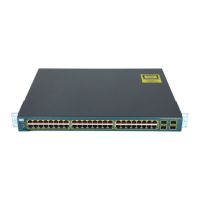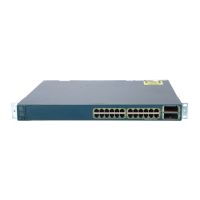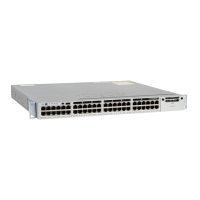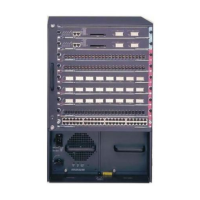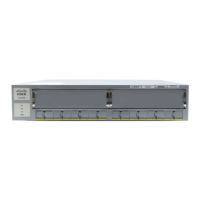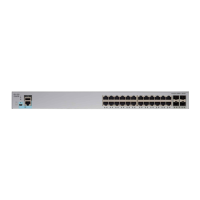13-7
Catalyst 3750 Switch Software Configuration Guide
78-16180-02
Chapter 13 Configuring VLANs
Configuring Normal-Range VLANs
are several adjacent switches that all have run out of spanning-tree instances. You can prevent this
possibility by setting allowed lists on the trunk ports of switches that have used up their allocation
of spanning-tree instances.
If the number of VLANs on the switch exceeds the number of supported spanning tree instances, we
recommend that you configure the IEEE 802.1s Multiple STP (MSTP) on your switch to map
multiple VLANs to a single STP instance. For more information about MSTP, see Chapter 18,
“Configuring MSTP.”
• When a switch in a stack learns a new VLAN or deletes or modifies an existing VLAN (either
through VTP over network ports or through the CLI), the VLAN information is communicated to all
stack members.
• When a switch joins a stack or when stacks merge, VTP information (the vlan.dat file) on the new
switches will be consistent with the stack master.
VLAN Configuration Mode Options
You can configure normal-range VLANs (with VLAN IDs 1 to 1005) by using these two configuration
modes:
• VLAN Configuration in config-vlan Mode, page 13-7
You access config-vlan mode by entering the vlan vlan-id global configuration command.
• VLAN Configuration in VLAN Database Configuration Mode, page 13-7
You access VLAN database configuration mode by entering the vlan database privileged EXEC
command.
VLAN Configuration in config-vlan Mode
To access config-vlan mode, enter the vlan global configuration command with a VLAN ID. Enter a new
VLAN ID to create a VLAN, or enter an existing VLAN ID to modify the VLAN. You can use the default
VLAN configuration (Table 13-2) or enter multiple commands to configure the VLAN. For more
information about commands available in this mode, refer to the vlan global configuration command
description in the command reference for this release. When you have finished the configuration, you
must exit config-vlan mode for the configuration to take effect. To display the VLAN configuration,
enter the show vlan privileged EXEC command.
You must use this config-vlan mode when creating extended-range VLANs (VLAN IDs greater than
1005). See the “Configuring Extended-Range VLANs” section on page 13-12.
VLAN Configuration in VLAN Database Configuration Mode
To access VLAN database configuration mode, enter the vlan database privileged EXEC command.
Then enter the vlan command with a new VLAN ID to create a VLAN, or enter an existing VLAN ID
to modify the VLAN. You can use the default VLAN configuration (Table 13-2) or enter multiple
commands to configure the VLAN. For more information about keywords available in this mode, refer
to the vlan VLAN database configuration command description in the command reference for this
release. When you have finished the configuration, you must enter apply or exit for the configuration to
take effect. When you enter the exit command, it applies all commands and updates the VLAN database.
VTP messages are sent to other switches in the VTP domain, and the privileged EXEC mode prompt
appears.

